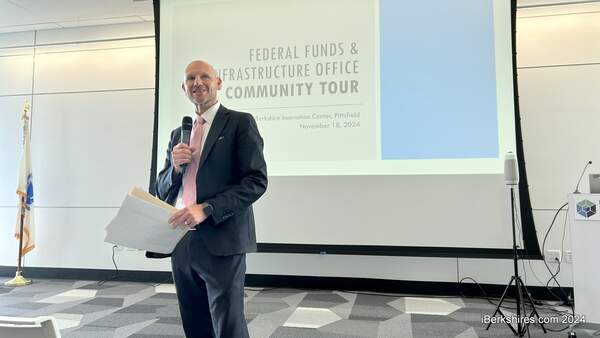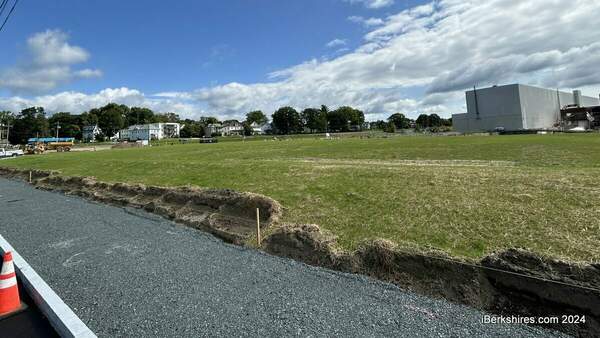Governor to Compete for Federal Grants for Clean Energy Infrastructure
BOSTON — The Healey-Driscoll Administration announced a project application for federal transmission funding that would deliver clean, affordable offshore wind and solar for the Commonwealth.
To jumpstart state and regional collaboration on necessary transmission infrastructure, the Department of Energy Resources submitted an application to the U.S. Department of Energy's Grid Innovation Program (GIP) for the innovative Cleaner Grid New England Project (CGNE Project) in partnership with Eversource and National Grid. The GIP award is a matching grant of up to $250 million. These funds were made possible by the Infrastructure Investment and Jobs Act.
The CGNE Project includes two subprojects that would be completed by project partners, Eversource and National Grid. The project enables interconnection for approximately 3,600 megawatts (MW) of offshore wind generation by increasing the grid's hosting capacity by approximately 2,400 MW in the Brayton Point area and at least 1,200 MW on the South Coast. The project would also enable the incremental interconnection of 300 MW of solar resources. National Grid's Greener Grid Brayton Point (GGBP) project proposes to construct two new substations at Grand Army and Brayton Point. Eversource's Southeastern Massachusetts Clean Grid (SEMA) project proposes to build a new substation to enable connection to offshore wind generation, as well as a substation to enable connection to solar generation on the South Coast.
"Massachusetts is competing hard for every federal dollar available to lower costs for consumers, maximize benefits for the state's ratepayers, and deliver clean energy to our homes and business,"
said Governor Maura Healey. "A future-ready transmission system will be key to meeting our ambitious climate limits."
In seeking federal funds, the CGNE Project provides an opportunity to capture significant benefits for the Commonwealth and the region. Funding through the DOE program would offset costs for transmission infrastructure that supports Massachusetts' clean energy goals, increase energy reliability and resilience, and provide necessary innovation in transmission planning and project development. Massachusetts will consider whether to move forward with the project following the receipt of any DOE award.
This application is a first step toward a multi-state, regional approach to integrating renewable energy into New England's electric grid. Earlier this year, Massachusetts joined the New England States to develop the Joint State Innovation Partnership for Offshore Wind, a concept paper submitted to the DOE's Grid Innovation Program.
Massachusetts is collaborating with the other New England States on pursuing federal investments into our transmission system to fully enable clean energy resources. This will help lower costs to ratepayers, maintain system reliability, help meet regional clean energy goals, and reduce our exposure to expensive and carbon-intensive imported fossil fuels.
"Transmission is the great enabler of offshore wind in Massachusetts and the region," said Energy and Environmental Affairs Secretary Rebecca Tepper. "With new energy sources coming online, it's critical that we also build out transmission to deliver this new energy to our residents. Investment in the transmission network will reduce congestion on our shared electric system, help our region transition to a clean energy future, and strengthens the grid's reliability and resilience for the people and businesses that rely on it."
The CGNE Project includes a robust Community Benefits Plan that describes specific actions the project developers will take related to community engagement, workforce development, and diversity, equity,
inclusion, and accessibility. A major goal of the DOE's GIP opportunity is to advance the interests of and opportunities for disadvantaged communities as infrastructure is developed.
The CGNE Community Benefits Plan includes the four goals outlined by DOE:
-
Supporting meaningful community and labor engagement;
-
Investing in the workforce;
-
Advancing diversity, equity, inclusion, and accessibility; and,
-
Contributing to the goal that 40 percent of the overall benefits of certain federal investments flow to disadvantaged communities, also known as the Justice40 Initiative.
"As Massachusetts makes the clean energy transition, delivering that clean offshore wind energy to customers is a critical piece of that shift. The Healey Administration and the DOER secured the support of five New England states and worked with Eversource and National Grid to advance what could be an historic investment in our region's infrastructure. If this project is chosen by the Department of Energy, it stands to benefit the entire New England region, creating thousands of jobs and significant economic opportunity for southeastern Massachusetts," said Stephen Woerner, President of National Grid New England. "National Grid looks forward to partnering on this project to help the state meet its clean energy goals."















